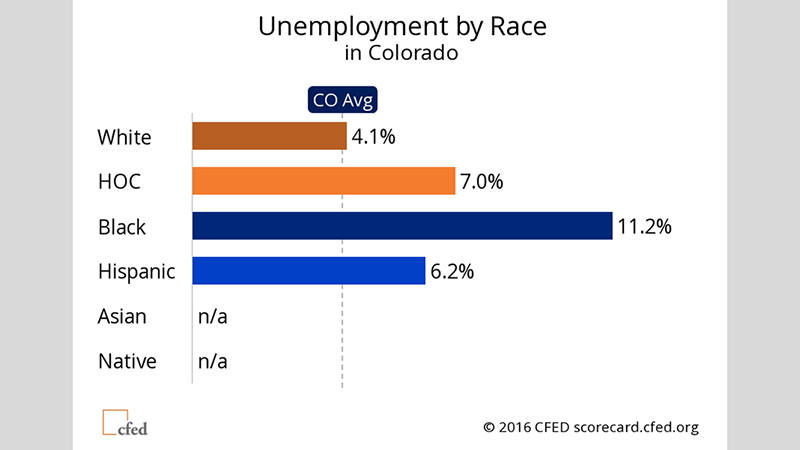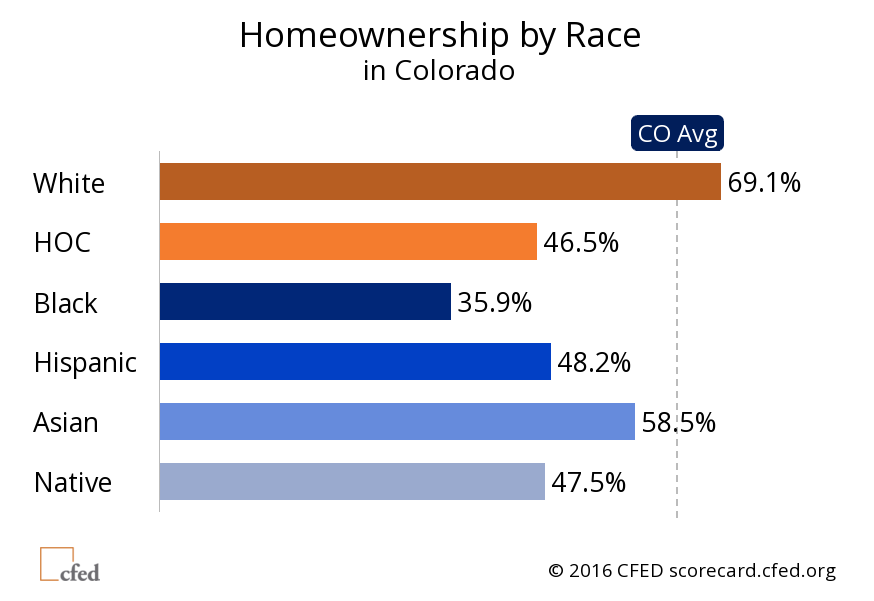
Black Coloradans were nearly three times as likely to be unemployed in 2015 as their white peers, according to data compiled by the Corporation for Enterprise Development.
Black Coloradans were nearly three times as likely to be unemployed in 2015 as their white peers, according to data compiled by the Corporation for Enterprise Development.
Blacks, Latinos and American Indians face systematic barriers to building wealth in Colorado and around the country—from when and where they are able to buy homes, to how much money they inherit from their parents, to their lifetime household income.
The latest view of racial and income inequality in the U.S. shows deep and entrenched disparities along racial lines, according to data released last week by the Corporation for Enterprise Development. Hamilton Nolan of Gawker gives a good run-down of the racial wealth gap in the U.S..
How does it play out in Colorado? Not well. Across a range of measures, Colorado is failing to provide equitable opportunities across racial lines.
Unemployment: The unemployment rate in Colorado for whites is 4.1 percent. For Latinos, it’s 6.2 percent, and for blacks, it’s 11.2 percent. To put this in context, a black Coloradan was much more likely to be unemployed in 2015 than a white Coloradan was in 2010, when the recession had taken its worst toll on the job market.
Poverty: Among American Indians in Colorado, 22.9 percent have income below the federal poverty line, compared with 21.1 percent of Latinos, 20.2 percent of blacks, 15.6 percent of Asians and 8.9 percent of whites. There’s a stark racial disparity in the percentage of Coloradans who have asset poverty—defined as not having enough net worth to live at the poverty level for three months. White Colorado households experience asset poverty at a rate of 18.7 percent, versus 23.9 percent for all Colorado households. Median household net worth for white families in Colorado is $127,113, compared with a statewide average of $78,398.
At a national level, even more granular data is available to compare net worth across racial lines, and it’s stunning: $110,637 for white households, $8,985 for Latino households and $7,113 for black households. These aren’t typos; nationally, the average white household has 12 times the net worth of the average Latino household and nearly 16 times the net worth of the average black household. Homeownership is likely the biggest contributor to the racial disparity in net worth, according to a report by the public policy group Demos. Both the lower rates of homeownership among communities of color and the lower return on their investments play a part in widening the gap. Income disparities, too, contribute to the gaping inequity in net worth, and, to a lesser extent, education.
Homeownership: About 69.1 percent of white households in Colorado own their own homes. That’s nearly twice the rate of black homeownership in the state, which is 35.9 percent. Around 58.5 percent of Asians, 48.2 percent of Latinos and 47.5 percent of American Indians own their own homes. Across racial lines, a huge segment of Colorado renters are paying more than 30 percent of their income in rent—a level that economists have defined as burdensome. But again, disparities persist. Among white renters, 47.6 percent are cost-burdened, compared with 41.3 percent of Asian renters, 52.3 percent of blacks, 52.6 percent of Latinos and 59.5 percent of American Indians.

Whites in Colorado are roughly twice as likely as blacks to own a home, according to Corporation for Enterprise Development data. Homeownership is a major contributor to white Americans having more than ten times the average net worth of black or Latino Americans.
 Business ownership: American Indian workers are most likely to own a business in Colorado, at 35.9 percent, compared with 27.9 percent of Asian workers, 22.7 percent of whites, 11.9 percent of blacks and 11.5 percent of Latinos. But the average value of white-owned businesses, at $498,765, is more than three times the value of an Indian-owned firm, at $151,308, and more than four times the average value of a black-owned business, at $108,866. The average business value of Latino-owned firms is $124,644, and of Asian-owned companies, $319,649.
Business ownership: American Indian workers are most likely to own a business in Colorado, at 35.9 percent, compared with 27.9 percent of Asian workers, 22.7 percent of whites, 11.9 percent of blacks and 11.5 percent of Latinos. But the average value of white-owned businesses, at $498,765, is more than three times the value of an Indian-owned firm, at $151,308, and more than four times the average value of a black-owned business, at $108,866. The average business value of Latino-owned firms is $124,644, and of Asian-owned companies, $319,649.
Health insurance: The Corporation for Enterprise Development cites data from 2014 showing that 8.4 percent of whites were uninsured in Colorado, compared with 21.5 percent of Latinos, 15.2 percent of American Indians, 11 percent of Asians and 10.9 percent of blacks. This is outdated information; the Colorado Health Institute’s 2015 Colorado Health Access Survey (sponsored by The Colorado Trust) found more people were covered. But disparities have survived: Just 5 percent of white Coloradans are without insurance, according to the Colorado Health Institute count, versus 11.8 percent of Latinos.
Education: Colorado does worse than 47 states when it comes to awarding four-year degrees to people of color. White adults are 2.2 times likelier than minorities to have a four-year college degree. Around 51.5 percent of Asian 25-year-olds have a college degree, 44.4 percent of whites, 23.2 percent of blacks, 19.4 percent of American Indians and 13.6 percent of Latinos. The disparities start early, with 84 percent of Asian students graduating from high school in four years, 83.2 percent of white students, 69 percent of blacks, 66.7 percent of Latinos and 61 percent of American Indians.
The Colorado Center on Law & Policy, an advocate for low-income Coloradans and a grantee of The Colorado Trust, has posted a scorecard of Colorado’s outcomes on its website, along with more analysis.